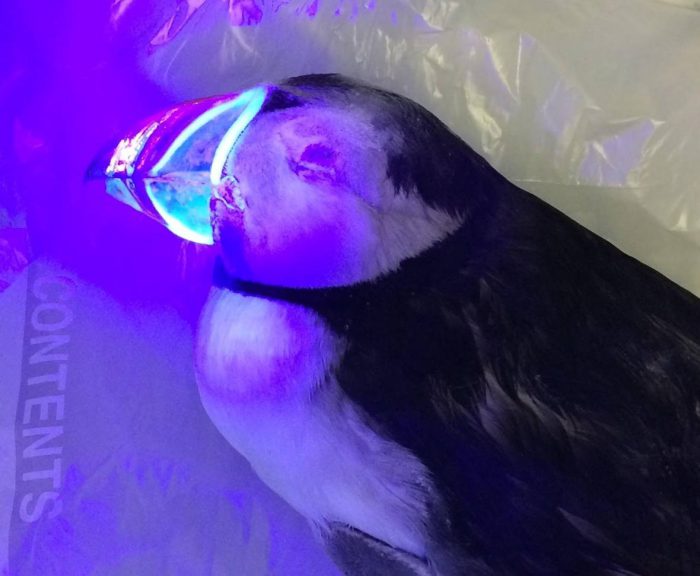Puffins. These North Atlantic seabirds are awfully adorable. Their doe eyes and striking black-and-white, "penguin-meets-duck" waddling body. Even their name is just ... gah! Don't you just want to give that word a big squeeze? PUFFINS!
Of course, we all know that the biggest attraction is that magnificent beak. Colourful and large, this striking feature ranks alongside those of the toucan and pelican as some of the greatest bird beaks around. And you know what? It's about to get EVEN BETTER.
Are you ready for this?

Puffin beaks glow.
Under UV light
Wait, what? Why are we only hearing about this now?
Not glowing in the dark. (Getty Embed)
Okay. To be clear, the beaks on puffins don't just glow in the dark. We'd obviously have noticed this by now. The news broke thanks to a lucky hunch played by a British ornithologist (bird scientist) named Jamie Dunning. During some work in his lab, he decided to try shining a UV (ultraviolet) light on a puffin. The bird's beak responded by fluorescing—or glowing by absorbing and then reemitting the UV rays.
Dunning excitedly published a paper about his findings, only to find that some scientists at the University of New Brunswick claim to have also made the same discovery in 2011. Regardless of who was first, what matters is that the secret is out. Glowing beaks!
Special sight
Human vision is limited to this colour spectrum, but birds can see beyond it. (Getty Embed)
So the natural question about this natural phenomenon is: Why do puffins have fluorescent beaks? UV light is normally invisible to humans (the word ultraviolet means "beyond violet", which is the highest colour spectrum visible by humans). Our vision is based in an RGB (red green blue) spectrum. But birds have an extra colour in the mix, giving them tetrachromatic vision. In other words, they can see colors that we don't even comprehend.
Is this glowing something that puffins can comprehend? Almost certainly, though it's difficult to say if it would "glow" in their eyes. Most likely, it would just look very beautiful. As in, even more beautiful than puffins already are.
Oh, sweet puffins. We had no idea we could love you more. And yet, here we are!
 We know it's difficult to imagine puffins being any more adorable than they already are, but just you wait...
(Karen Miller | Dreamstime.com)
We know it's difficult to imagine puffins being any more adorable than they already are, but just you wait...
(Karen Miller | Dreamstime.com)










I did not know that before and it is so cool. 🙂 🙂
I agree. 😉 😆
😆 Thats AWESOME!!!
Awesome 😛 😛 😛 😛 😛 😛 😎 😎 😎 😎 😎 🙂 🙂 🙂 🙂 🙂 😮 😮 😮 😮 😀 😀 😀 😀 😉 😉 😉 😉 😉
Hi I’m so pleased to have read your article on puffins I adore these little chaps and was lucky enough to see one bobbing along on the se just behind Irelands Eye when i was out on my hu sbands fishing trawler.